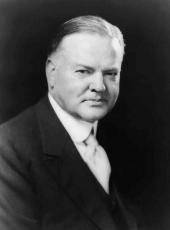THE PRESIDENT reported the following conclusions have been so far arrived at by the Conference:
We have canvassed the information secured by State and national surveys as to drought conditions. While the extent of the damage cannot yet be determined, it is certain that there are at least 250 counties most acutely affected where some degree of relief must be provided. It was the view of the Conference that the burden of effective organization to meet the situation over the winter in the acutely affected counties rests primarily upon the counties and the States themselves, supplemented by such cooperation and assistance as may be found necessary on the part of the Federal Government.
The objective of such relief is:
(a) To assist families over the winter who are deprived of means of support through failure of their crops.
(b) To prevent unnecessary sacrifice of livestock.
(c) Protection to public health.
This is to be accomplished by:
(a) Placing of loans privately or where necessary with assistance of State or national agencies.
(b) Red Cross assistance.
(c) Employment.
(d) Reduced railway rates for food, feed, and livestock to the distressed districts.
This relief can be achieved justly and effectively only upon, first, a determination of the counties where such assistance is required, and second, upon an accurate determination of the needs of each family. In order that such determinations may be made and assistance supplied as each case may require, the following organization is agreed upon:
1. Each Governor who considers that a situation requiring emergency relief exists within his State shall create a drought relief committee under the chairmanship of a leading citizen, and embracing in its membership a State agricultural official, a leading banker, a Red Cross representative, a railway representative, and such farmers and others as the situation may require. This committee to take general charge of relief measures within the State.
2. The State committee to determine the drought counties where there is need for organized relief and to organize a committee in each such county, likewise under the chairmanship of a leading citizen, and embracing the county agricultural agent, a leading banker, county Red Cross leader, farmers, and others.
3. The county committees will receive individual applications for relief and recommend the method of treatment, and coordinate the various agencies in service thereto by way of loans, Red Cross assistance, employment, et cetera. The State committees, in cooperation with the county committees, to determine which counties are in need beyond the resources of the people of the county and in what direction, i.e. whether loans are required beyond the ability of the local banks, or Red Cross assistance beyond the resources of the county chapter; what quantities of imports of feed or food are required, et cetera. The State committee to cooperate with national agencies if these requirements are beyond the State resources.
4. The President will set up a committee comprising representatives of the Department of Agriculture, the Federal Farm Board, the Federal Farm Loan Board, the Red Cross, the American Railway Association, the Public Health Service. This committee, through its chairman, will coordinate national activities and national support to the State and county committees.
5. The methods for provision of credit beyond local or State resources for the purchase of feed, seed, movement of livestock, or support of families over the winter will be developed by State committees in cooperation with the Federal Farm Board, the Federal Farm Loan Board, the Intermediate Credit System, and other Federal agencies.
6. The Red Cross will organize its own committees in each drought county, the chairman of which will be a member of the county drought relief committee. The National Red Cross has made a preliminary allocation of $5 million pending determination of the aggregate need.
7. The railways have already generously reduced rates by 50 percent on food and feed inward to the drought counties and livestock movement outward, to dealers and persons who are entitled to relief and so designated by the county agents or the committees created above.
8. The Department of Agriculture will secure and disseminate information as to sources of feed supply and localities to which livestock may be shipped. It will examine the possibilities of advancing State road allotments to drought areas in order to increase employment.
9. In the States of Iowa, Nebraska, and Kansas, and others having a surplus of feed, it is recommended that a State committee be set up to cooperate with the committees in the States of surplus livestock.
Note: On the same day, the White House released the following list of participants in the White House Conference on Drought Relief:
THE SECRETARY OF AGRICULTURE
GOVERNOR HENRY S. CAULFIELD, of Missouri
GOVERNOR Louis L. EMMERSON, of Illinois
GOVERNOR HARRY G. LESLIE, of Indian
GOVERNOR MYERS T. COOPER, of Ohio
GOVERNOR WILLIAM G. CONLEY, of West Virginia
GOVERNOR JOHN GARLAND POLLARD, Of Virginia
GOVERNOR JOHN E. ERICKSON, of Montana
GOVERNOR ARTHUR I. WEAVER, of Nebraska
GOVERNOR JOHN HAMMILL, of Iowa
GOVERNOR CLYDE M. REED, of Kansas
HARVEY T. HARRISON as proxy for Governor Harvey Parnell, of Arkansas
SENATOR JOSEPH T. ROBINSON as proxy for Governor Flem D. Sampson, of Kentucky
COMMISSIONER W. S. FITTS as proxy for Governor Henry H. Horton, of Tennessee
MR. ALEXANDER LEGGE, Federal Farm Board
MR. JAMES C. STONE, Federal Farm Board
MR. CHARLES S. WILSON, Federal Farm Board
MR. HORACE PAUL BESTOR, Farm Loan Commissioner, Federal Farm Loan Bureau
JUDGE JOHN BARTON PAYNE, American National Red Cross
Herbert Hoover, Statement on the White House Conference on Drought Relief. Online by Gerhard Peters and John T. Woolley, The American Presidency Project https://www.presidency.ucsb.edu/node/211356

